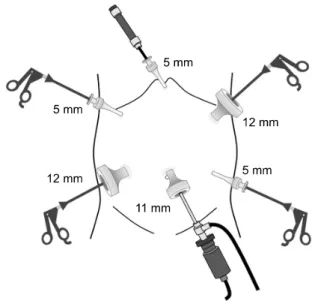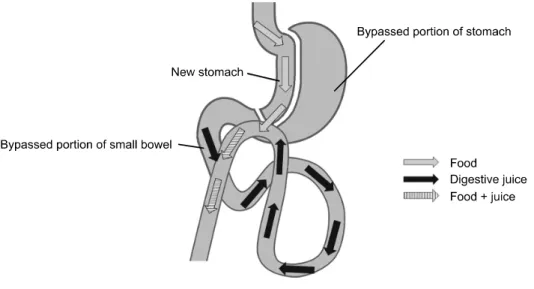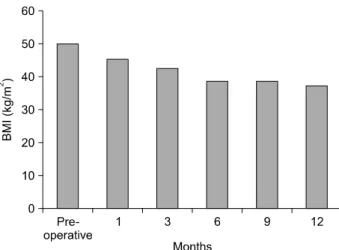ORIGINAL ARTICLE
JMBS Journal of Metabolic and Bariatric Surgery https://doi.org/10.17476/jmbs.2019.8.2.43
Received: October 22, 2019, Revised: November 11, 2019, Accepted: November 13, 2019 Corresponding author: Sang Hyun Kim, 59 Daesagwan-ro, Yongsan-gu, Seoul 04401, Korea
Department of Surgery, Soonchunhyang University Hospital Seoul, Soonchunhyang University School of Medicine Tel: +82-2-710-3234, Fax: +82-2-710-3088, E-mail: ssan77@naver.com, ssan77gs@gmail.com
CC This is an open access article distributed under the terms of the Creative Commons Attribution Non-Commercial License (http://creativecommons.org/licenses/by-nc/4.0) which permits unrestricted non-commercial use, distribution, and reproduction in any medium, provided the original work is properly cited.
Initial Experience with Laparoscopic Mini-gastric Bypass in Korean Obese Patients
1
Department of Surgery, Soonchunhyang University Hospital Seoul, Soonchunhyang University School of Medicine,
2Department of Surgery, H plus Yangji Hospital, Seoul, Korea
Chae Dong Lim
1, Sang Hyun Kim
1, Yong Jin Kim
2Purpose: To report our initial experience with laparoscopic mini-gastric bypass (LMGB) in Korean obese patients. Materials and Methods: From July 2016 to February 2018, 14 male patients underwent LMGB for morbid obesity at a single institution. Five trocars were placed in a U-shape formation and 1 trocar was placed at the epigastrium as a liver retractor;
a window was created between the vagal nerve and lesser curvature at the gastric angle for entering the lesser sac; a narrow gastric tube (∼100-120 ml volume) was made; a linear-stapled gastrojejunostomy was created after bypassing the jejunum 200 cm from the Treitz’ ligament; and the Petersen defect was closed to prevent internal hernia. Patient demographics, operative time, estimated blood loss, postoperative hospital stay, complications, weight loss, and resolution of comorbidities were evaluated during 1 year of follow-up. Results: All procedures were successful by laparoscopy. The average age was 29 (19-49) years; weight, 164.9 (127-250) kg; and body mass index, 51.0 (42.4-81.6) kg/m
2. In 1 case, nephrectomy was simultaneously performed for early renal cell carcinoma. The mean operative time was 148.8 (120-175) min. The mean postoperative hospital stay was 1.9 (1-4) days. The percentage excess weight loss at 1, 3, 6, 9, and 12 months was 16.6%, 31.0%, 41.4%, 45.4%, and 50.4%, respectively. The resolution rate of type 2 diabetes mellitus, hypertension, and dyslipidemia was 75%, 40%, and 66.7%, respectively. There was no major complication including mortality during the follow-up. Conclusion: LMGB is a technically simple, safe, and effective procedure in Korean obese patients.
Key Words: Mini-gastric Bypass, Bariatric surgery, Metabolic Surgery, Morbid Obesity
INTRODUCTION
Obesity is one of the most important health issues worldwide. Recently, bariatric surgery has become the best treatment option for morbid obesity and related comorbidities, as it has been shown to be more effective than medical therapy or lifestyle modification [1-3]. To date, laparoscopic Roux-en-Y gastric bypass (LRYGB) is the gold standard procedure for morbid obesity among
various types of surgical procedures [4]. However, LRYGB remains technically challenging and ranks as one of the most difficult laparoscopic surgeries, especially for inex- perienced surgeons [4,5]. It has a highly steep learning curve and is associated with longer operating times and higher perioperative complication rates in the upward portion of the curve [6].
Laparoscopic mini-gastric bypass (LMGB) was first
proposed by Rutledge in 2001 [7]. The procedure consists
Fig. 1. Position of the trocars in laparoscopic mini-gastric bypass.
of a long lesser-curvature gastric tube with gastro- jejunostomy performed 200 cm distal to the Treitz’
ligament. This procedure, similar to LRYGB, causes weight loss through both restrictive and hypoabsorptive me- chanisms. There are several apparent advantages of LMGB over LRYGB. LMGB has a shorter learning curve because the side-to-side loop gastrojejunostomy in LMGB is technically easier to perform than the Roux-en-Y- fashioned anastomosis in LRYGB. In addition, LMGB has a lower potential risk of internal herniation than LRYGB because the internal defect after LMGB is less than that after LRYGB. Moreover, LMGB is easier to revise or reverse than LRYGB because of the simplicity of the technique.
However, despite the several benefits of LMGB along with its equivalent effects to those of LRYGB in terms of weight loss and resolution of comorbidities, concerns related to symptomatic alkaline reflux and the risk of gastric/
esophageal cancer have prevented its adoption [8].
During the last 20 years, a number of surgeons from different countries have been able to replicate these results and >16,000 published cases now exist in the surgical literature [9]. We believe that there is now sufficient evidence supporting the adoption of this procedure as another surgical treatment option. However, to date, published studies on LMGB in Korean obese patients are scarce [10]. Therefore, we aimed to describe our initial experience with LMGB in Korean obese patients.
MATERIALS AND METHODS
1. Patients
We retrospectively reviewed the prospectively collected medical records of Korean obese patients who underwent LMGB for the treatment of morbid obesity from July 2016 to February 2018 at a single institution. The patients’ demo- graphics, operative time, estimated blood loss, posto- perative hospital stay, early and late complications, weight loss, and resolution of comorbidities were evaluated during 1 year of follow-up after surgery.
2. Definitions of ideal body weight, remission of comorbidities, and complications
Ideal body weight was defined as the weight corre-
sponding to a body mass index (BMI) of 23 kg/m
2, and excess weight loss was defined as the difference between a patient’s real weight at baseline and the ideal body weight. The percentage excess weight loss (%EWL) and the change in mean BMI were used to evaluate weight loss. The outcomes of comorbidities and complications were based on the standardized outcome reporting in metabolic and bariatric surgery published by Brethauer et al. [11] in 2015.
Remission of comorbidities, such as type 2 diabetes mellitus (T2DM), hypertension, or dyslipidemia, means normalized values of the clinical parameters of each comorbid condition without the need for any medication, and improvement means the decrease in the values of the clinical parameters with the same medications or a decrease in the dosage or number of medications. Com- plications were reported according to 2 different methods:
based on the time frame (early [<30 days] vs. late [>30 days]) and based on the complication itself (major vs.
minor).
3. Surgical techniques
Each patient was placed in the reverse Trendelenburg
supine position. The surgeon and camera operator stood
on the right side of the patient, and an assistant stood on
the left side of the patient. The main monitor was at the
head of the operating table to the left side of the patient,
Fig. 2. Schematic diagram of the laparoscopic mini-gastric bypass procedure.
and the secondary monitor was at the right side of the patient. First, by using a 0
ooptic scope, a 12-mm trocar was placed on the left hypochondrium and a pneumo- peritoneum was made. After changing to a 30
ooptic scope, the second trocar (11 mm) was placed on the umbilicus for the camera. The third trocar (12 mm) was placed on the right side of the same horizontal level of the camera port at the mid-clavicular line. The fourth trocar (5 mm) was placed on the right hypochondrium, and the fifth trocar (5 mm) was placed on the left side of the same horizontal level of the camera port at the mid-clavicular line. The 5 trocars were placed in a U-shape formation. Finally, a 5-mm trocar for retracting the liver was placed just below the xiphoid process (Fig. 1). A window was created between the vagal nerve and the lesser curvature at the gastric angle for entering the lesser sac. Through the created window, a linear stapler loaded with a 45-mm purple cartridge (Endo-GIA
TM; Medtronics, USA) was passed and applied horizontally. Thereafter, linear staplers with a 60-mm purple cartridge were passed vertically to the axis of the stomach and fired upward to the angle of His, creating a narrow gastric tube of approximately 100-120 ml volume.
The jejunum was mobilized upward, placing it without tension after bypassing 200 cm from the Treitz’ ligament.
Division of the omentum was sometimes required in obese patients with bulky omental fat. Gastrotomy and entero- tomy were performed using a monopolar energy device for the entry of the linear stapler, and a 2-cm gastrojejunal anastomosis was created using a linear stapler loaded with
a 45-mm purple cartridge in an antecolic fashion. The entry hole for the linear stapler was closed with extra- mucosal continuous sutures using braided absorbable 3-0 suture (Polysorb
TM, Medtronics). Thereafter, the Petersen defect was sewn with braided non-absorbable suture 2-0 (Ethibond Excel
Ⓡ; Ethicon, USA). Lastly, a leakage test with methylene blue dye was performed to confirm the anastomotic integrity. No closed drain was placed. Fig. 2 shows the schematic diagram of LMGB. Upper gastro- intestinal series were performed on the first postoperative day to check for leakage and passage.
RESULTS
All procedures were successful by laparoscopy. All patients were men with average age of 28.9 years (range 19-49 years). The mean operative time was 148.8 (120-175) min; the mean estimated blood loss was 50.7 (0-100) ml; and the average length of postoperative hospital stay was 1.9 (1-4) days. In 1 case, nephrectomy was simultaneously performed for early renal cell carcinoma.
The follow-up rate at postoperative 1 year was 78.6%
(11/14 patients).
The mean body weight at the time of operation was
164.9 (127-250) kg, and the mean BMI was 51.0 (42.4-
81.6) kg/m
2. The BMIs at postoperative 1, 3, 6, 9, and 12
months were 46.8 (36.1-79.0), 43.0 (33.0-75.4), 40.4
(30.0-68.6), 40.4 (28.7-66.3), and 38.7 (26.9-64.7) kg/m
2,
respectively (Fig. 3). The %EWL at postoperative 1, 3, 6, 9,
Fig. 4. Individual’s percentage excess weight loss (%EWL) after laparoscopic mini-gastric bypass.
Fig. 5. Glycated hemoglobin (HbA1c) level after laparoscopic mini-gastric bypass (%).
Fig. 3. Longitudinal changes of body mass index (BMI) in the study population (%).
Table 1. Resolution rate of obesity-related comorbidities after laparoscopic mini-gastric bypass
Problems Resolution rate (%)
Type 2 diabetes mellitus 75
Hypertension 40
Dyslipidemia 66.7
and 12 months were 16.6% (4.5-32.8%), 31.0% (10.6- 49.2%), 41.4% (22.3-63.9%), 45.4% (26.2-70.5%), and 50.4% (29.0-80.9%), respectively (Fig. 4).
Four (28.6%) patients had T2DM before surgery, and 3 of them had been prescribed with oral anti-diabetic agents.
Three of the 4 patients (75%) experienced resolution of T2DM at 1 year follow-up after surgery, and 1 patient achieved improvement of T2DM (Table 1). The level of glycated hemoglobin decreased from 9.3% (6.6-10.8%) at baseline to 5.2 (4.7-5.7%) at 1 year after surgery (Fig. 5).
Two of 5 patients (40%) with hypertension achieved resolution. On the other hand, 2 of 3 patients (66.7%) with dyslipidemia achieved resolution, and the remaining 1 patient experienced improvement of dyslipidemia after
surgery (Table 1).
There was no early complication or mortality after surgery in all patients. There was 1 case of late major complication involving marginal ulcer bleeding with melena requiring endoscopic intervention and transfusion of 2 pints of packed red blood cells at 3 months after surgery. Four (28.6%) patients had reflux gastroesophagitis requiring a proton pump inhibitor (PPI). Four patients (28.6%) developed marginal ulcers, and all were managed with PPI. Dumping syndromes were noted in 2 patients (14.3%), and anemia requiring supplementation of iron and vitamin B12 was noted in 1 patient (7.1%) (Table 2).
DISCUSSION
Our study demonstrated that LMGB has good short-term
outcomes in terms of weight loss and resolution of
comorbidities such as T2DM, hypertension, and dyslipidemia
in Korean obese patients. To our knowledge, only 1
previous study has reported the outcome of LMGB in
Korean patients [10]. Although this study included non-
obese patients with T2DM, it nevertheless showed that
Table 2. Complications of laparoscopic mini-gastric bypass
Complications Class Patients (%) Management
Marginal ulcer bleeding with melena Late major 1 (7.1) Blood transfusion and PPIs
Reflux gastroesophagitis Late minor 4 (28.6) PPIs
aMarginal ulcer Late minor 4 (28.6) PPIs
Dumping syndrome Late minor 2 (14.3) Dietary education
Anemia Late minor 1 (7.1) Iron and vitamin B12 supplement
a



